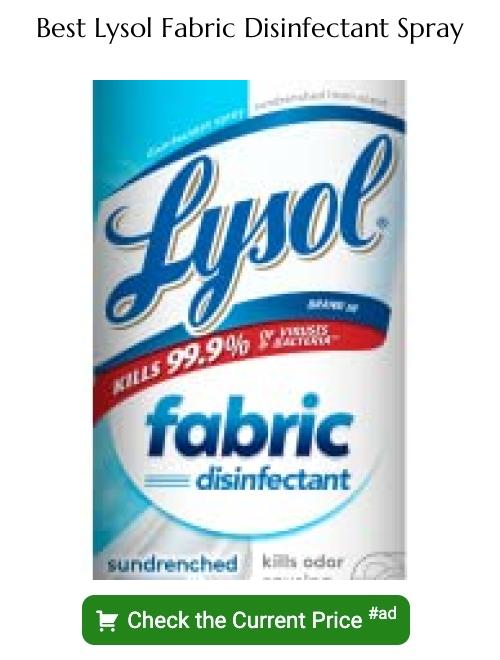Last updated on
Discover the effectiveness and safety of using Lysol spray on your fabric couch to keep it clean and germ-free.
As we spend more time at home, it’s important to keep our living spaces clean and sanitized. One common question that many homeowners have is whether or not they can use Lysol on their fabric couches.
After all, the last thing you want is to damage your furniture while trying to disinfect it. In this article, we’ll explore whether or not spraying Lysol on a fabric couch is safe and effective, as well as some alternative methods for keeping your furniture germ-free.
So let’s dive in!
Table of Contents
Fabrics and Couch Materials
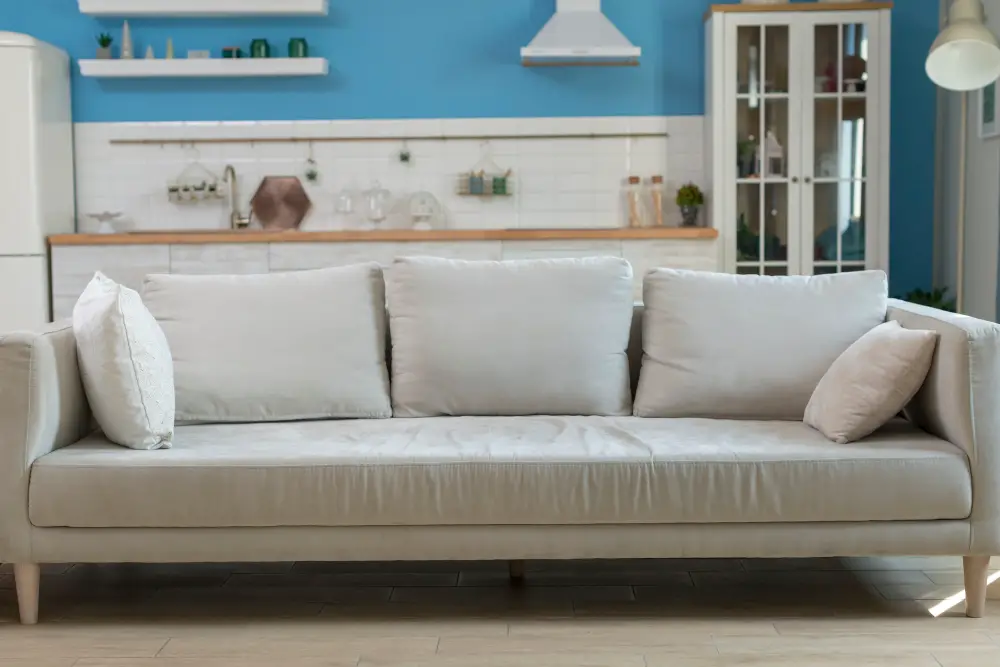
Different fabrics require different cleaning methods and products. Some common materials used for upholstery include cotton, linen, wool, polyester blends and microfiber.
Cotton and linen are natural fibers that can be durable but may also stain easily if not treated properly. Wool is another natural fiber that can be prone to shrinking or felting when exposed to water or heat.
Polyester blends are synthetic fibers that offer durability and resistance against stains but may not feel as soft as natural fibers like cotton or wool.
Microfiber has become increasingly popular in recent years due to its durability and ease of maintenance. It’s made from tightly woven synthetic fibers which make it resistant against spills while still being comfortable enough for everyday use.
Understanding what your couch is made of will help you determine how best to clean it without causing any damage.
Assessing the Couch Material

Not all fabrics are created equal and some may be more sensitive to certain cleaning products than others. For example, delicate materials like silk or velvet may not react well with harsh chemicals such as Lysol.
To determine if your couch is safe for disinfecting with Lysol spray, check the manufacturer’s label or consult their website for specific care instructions. If you’re unsure about the type of fabric used in your couch upholstery, try doing a spot test on an inconspicuous area before applying any cleaning solution.
It’s also worth noting that while leather sofas can be disinfected using Lysol spray, they require different care compared to fabric ones. Leather should be cleaned and conditioned regularly with specialized products designed specifically for this material.
Safety Precautions With Lysol

First and foremost, make sure that the room is well-ventilated by opening windows or turning on a fan. This will help prevent you from inhaling too much of the disinfectant spray.
It’s also important to wear gloves while applying Lysol to your couch. This will protect your skin from any potential irritation or allergic reactions that may occur.
Be mindful of any pets or children in the area when using Lysol spray. Keep them away from the sprayed area until it has fully dried and avoid spraying directly onto their toys or bedding.
Potential Effects On Fabrics
Some fabrics are more delicate than others and may not react well to certain chemicals. For example, using Lysol on silk or wool could cause discoloration or damage to the fibers.
Repeated use of Lysol spray can lead to a buildup of residue that can be difficult to remove from some fabrics. This residue can make your couch look dull and dingy over time.
It’s also worth noting that while Lysol is effective at killing germs and bacteria, it won’t necessarily remove stains or odors from your fabric couch. If you’re dealing with stubborn stains or unpleasant smells in addition to wanting a germ-free surface, you’ll need additional cleaning methods beyond just spraying with disinfectant.
Test On a Hidden Area
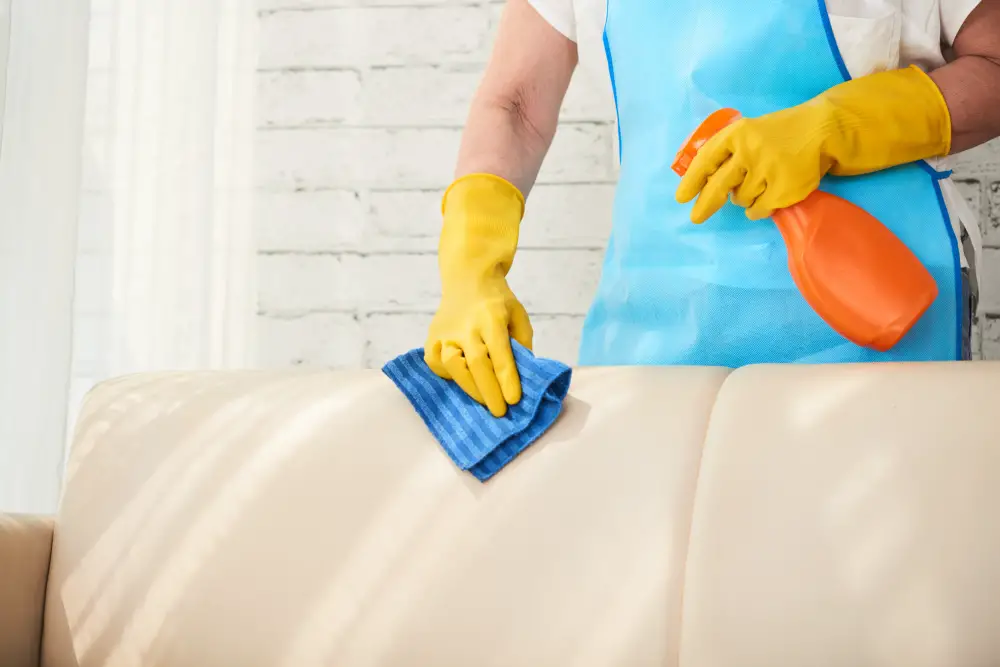
This will help you determine whether or not the spray will cause any discoloration or damage to the fabric. To do this, simply apply a small amount of Lysol spray onto an unseen part of your couch and wait for at least 10 minutes before wiping it off with a clean cloth.
If there are no visible signs of damage or discoloration after testing, then you can proceed with disinfecting your entire couch using Lysol spray. However, if there is any sign of damage or color change in the tested area, then avoid using Lysol on that particular material.
Testing on a hidden area is crucial as different fabrics react differently to cleaning agents like disinfectants. Some materials may be more sensitive than others and could easily get damaged by harsh chemicals such as bleach-based cleaners like some types of lysols sprays.
Preparing to Disinfect a Fabric Couch
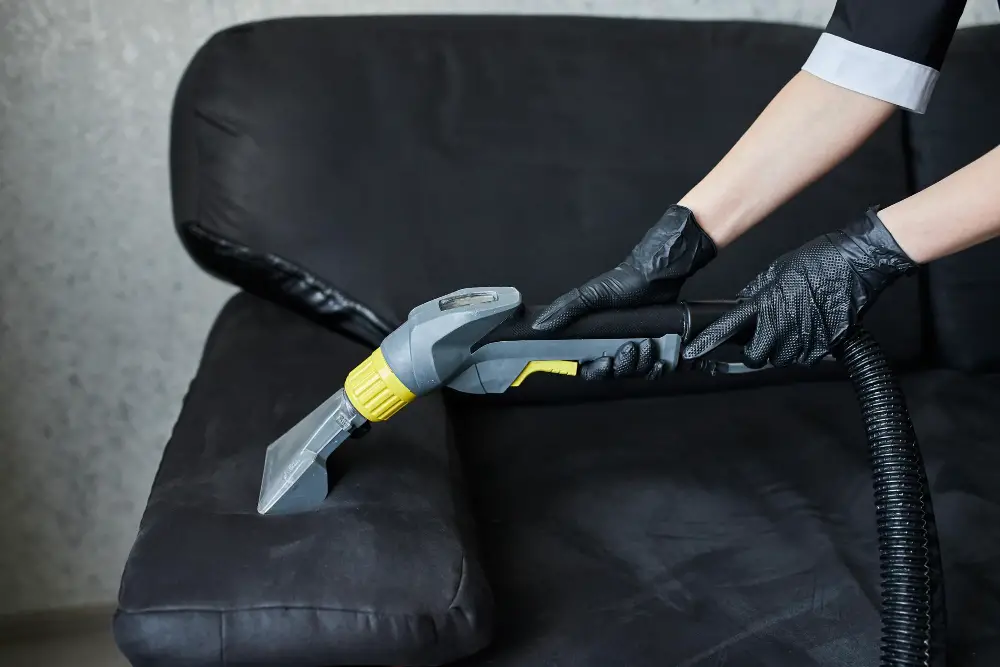
First, remove any loose cushions or pillows from the couch and set them aside. Next, use a vacuum cleaner with an upholstery attachment to thoroughly clean all surfaces of the couch.
This will help remove any dirt or debris that could interfere with the effectiveness of Lysol spray.
Once you’ve finished vacuuming, take a moment to assess any stains or spots on your fabric couch. If there are visible stains that need attention before disinfecting, consider using a stain remover specifically designed for upholstery fabrics.
It’s also essential to read and follow all safety precautions listed on the Lysol canister before use. Make sure you’re in a well-ventilated area and wear gloves if necessary.
Using Lysol Spray On Fabric Couch
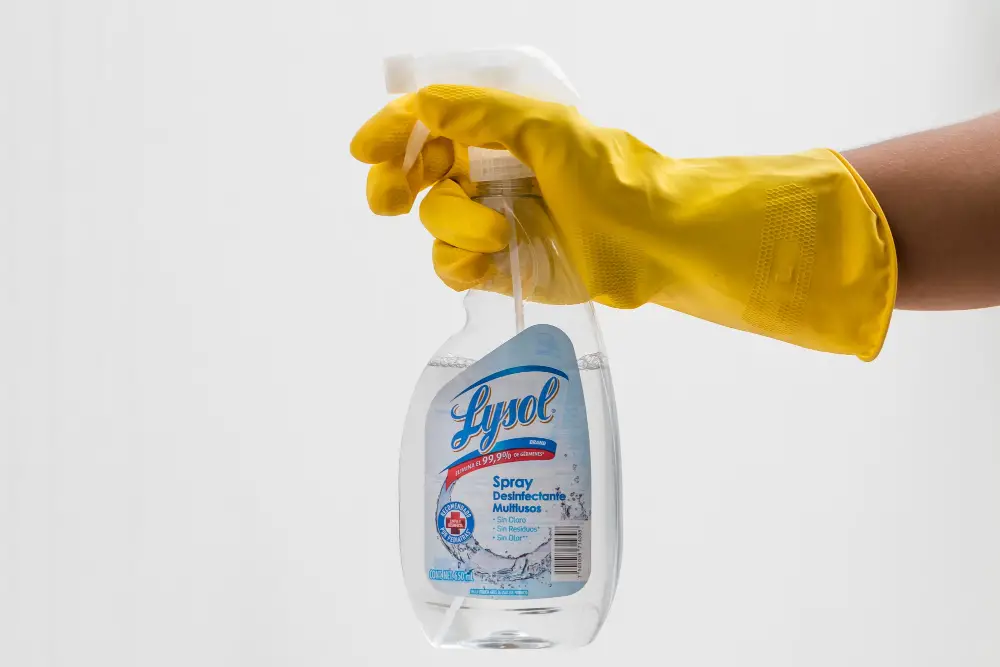
First and foremost, you should always test the spray on a small, inconspicuous area of the couch before applying it more broadly. This will help you ensure that the Lysol doesn’t cause any discoloration or damage to your furniture.
Assuming that your test patch goes well, you can then proceed with disinfecting your entire fabric couch using Lysol spray. To do this effectively:
- Shake the can well before use.
- Hold the can about 6 inches away from your furniture.
- Spray evenly across all surfaces of each cushion and along every seam line.
- Be sure not to oversaturate any one area as this could lead to watermarks or other damage.
Proper Lysol Spray Application
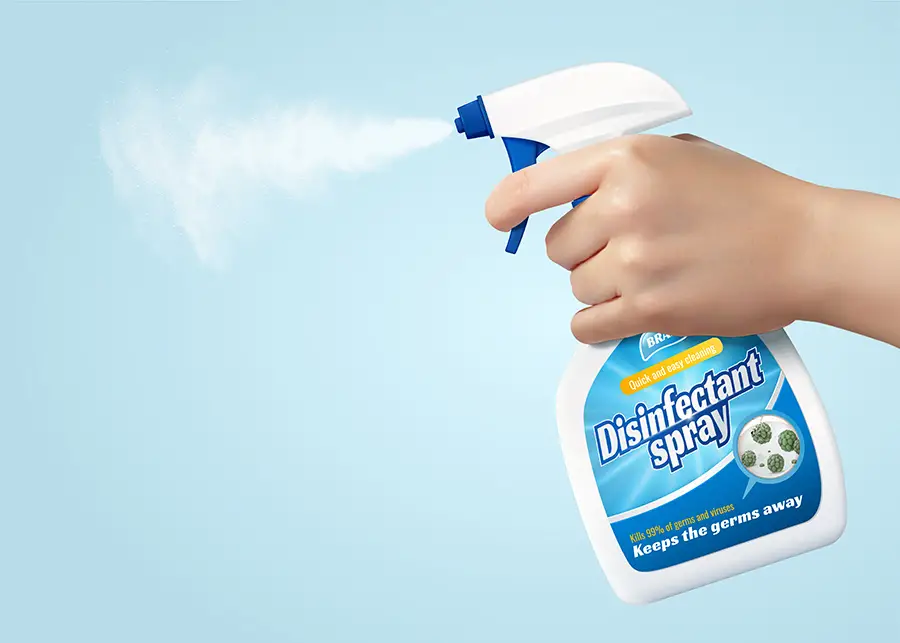
First and foremost, make sure you have read the instructions on the can carefully before use. Shake the can well and hold it about 6 inches away from your couch’s surface.
Spray a light mist of Lysol over all areas of your fabric couch that need disinfecting. Be careful not to oversaturate any one area as this could cause damage or discoloration to certain fabrics.
It’s important to note that while Lysol is effective at killing germs and bacteria, it may not be suitable for all types of fabrics or materials. Always test a small hidden area first before applying more widely across your furniture piece.
Once you’ve finished spraying down your entire sofa with Lysol spray, allow ample time for drying completely before sitting back down again – usually around 10-15 minutes should suffice depending on how much was applied in each spot.
Letting the Couch Dry

This will ensure that any remaining germs or bacteria are killed off and won’t spread throughout your home. Depending on the size of your couch and how much Lysol you used, drying time can vary from a few hours up to a full day.
To speed up the drying process, consider opening windows or turning on fans in the room where your couch is located. You can also use a clean towel or cloth to gently blot any excess moisture from the surface of your furniture.
Remember that allowing proper drying time is crucial for maintaining both cleanliness and longevity of upholstery fabrics. Rushing this step may lead not only to unpleasant odors but also mold growth which could damage both fabric fibers as well as cushion fillings over time.
Alternative Cleaning Methods
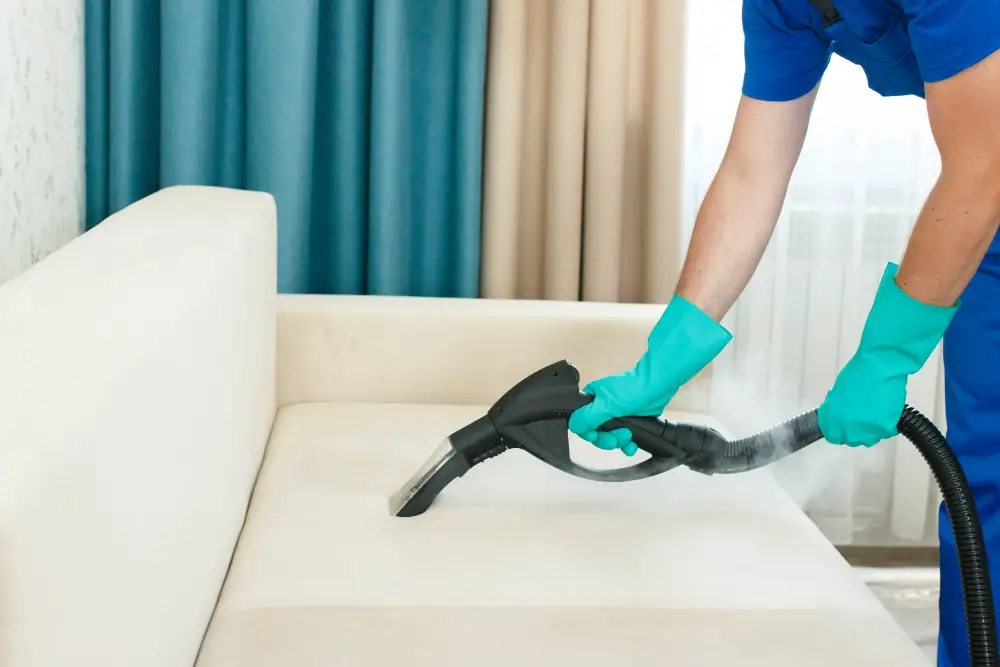
One option is to use a steam cleaner, which uses hot water vapor to penetrate deep into the fibers of your couch and kill bacteria and viruses. Another option is to make your own homemade disinfecting spray using natural ingredients like vinegar or essential oils.
If you have a microfiber couch, it’s important not to use water-based cleaners as they can leave behind stains or damage the material. Instead, try using rubbing alcohol on a cloth or brush in circular motions until the stain disappears.
For leather couches, avoid using harsh chemicals that could strip away its natural oils and cause cracking over time. Instead, opt for gentle soap solutions specifically designed for leather upholstery.
Cleaning Microfiber Couches

Cleaning them can be tricky as they require special care to maintain their appearance and texture. To clean a microfiber couch, start by vacuuming the surface with an upholstery attachment to remove any loose dirt or debris.
Next, use a soft-bristled brush or sponge to gently scrub any stains using circular motions.
Avoid using water on microfiber as it can leave watermarks that are difficult to remove. Instead, use rubbing alcohol or white vinegar mixed with distilled water in equal parts on stubborn stains.
Once you’ve finished cleaning your microfiber couch, allow it time to air dry completely before sitting on it again. Avoid placing the furniture in direct sunlight while drying as this may cause fading of the fabric’s color.
Caring for Leather Couches
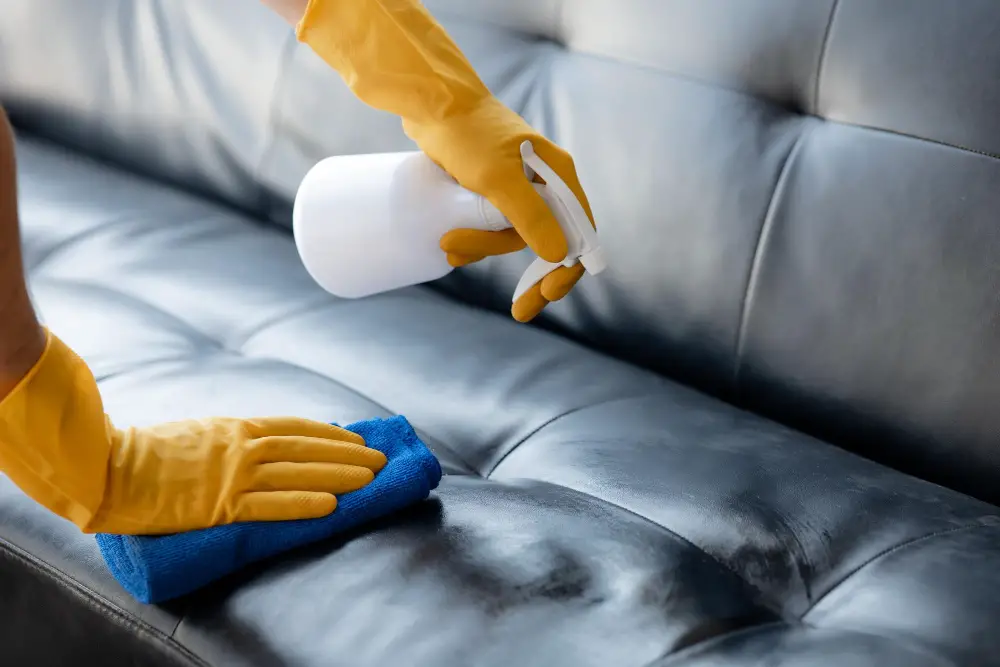
Caring for leather furniture requires some extra attention compared to other fabrics. When it comes to disinfecting your leather couch, it’s important not to use harsh chemicals or abrasive materials that can damage the material.
To clean and disinfect a leather couch, start by wiping down the surface with a soft cloth dampened with warm water. Avoid using too much water as this can cause discoloration or damage the finish of your sofa.
Next, mix equal parts white vinegar and distilled water in a spray bottle and lightly mist over the surface of your sofa. Gently wipe away any excess moisture with another soft cloth.
For tougher stains or spills on your leather couch, try using baking soda mixed with warm water into a paste-like consistency then apply onto affected areas gently rubbing them off after 10-15 minutes before wiping away any residue left behind.
Additional Cleaning Methods: Steam Cleaner
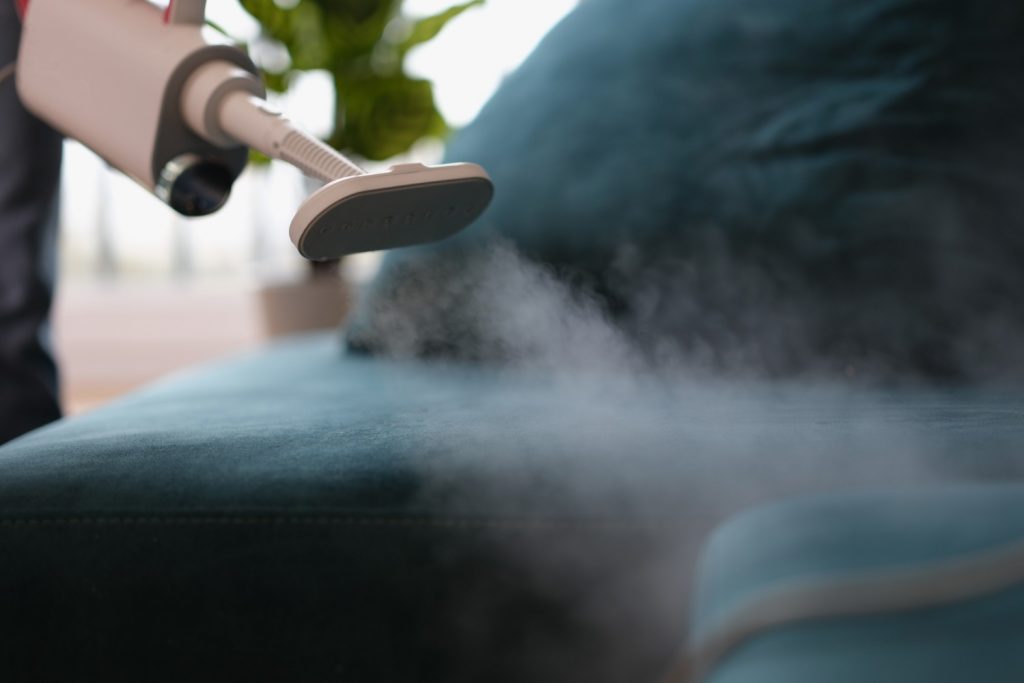
Steam cleaning uses high-temperature steam to kill germs, bacteria, and viruses that may be lurking on your furniture. It’s also an excellent method for removing stains and dirt from the surface of the couch.
To use a steam cleaner on your fabric couch, you’ll need to follow some basic steps. First, vacuum or brush off any loose debris or dust from the surface of the sofa.
Then fill up your steamer with water according to its instructions.
Next, turn on the machine and wait for it to heat up before starting cleaning in small sections at a time while holding down its trigger button as you move back-and-forth over each section slowly until all areas are covered evenly.
Once done with one section let it dry completely before moving onto another area so that no moisture remains trapped inside which could lead mold growth later down-the-line if not properly dried out beforehand!
Homemade Disinfecting Spray
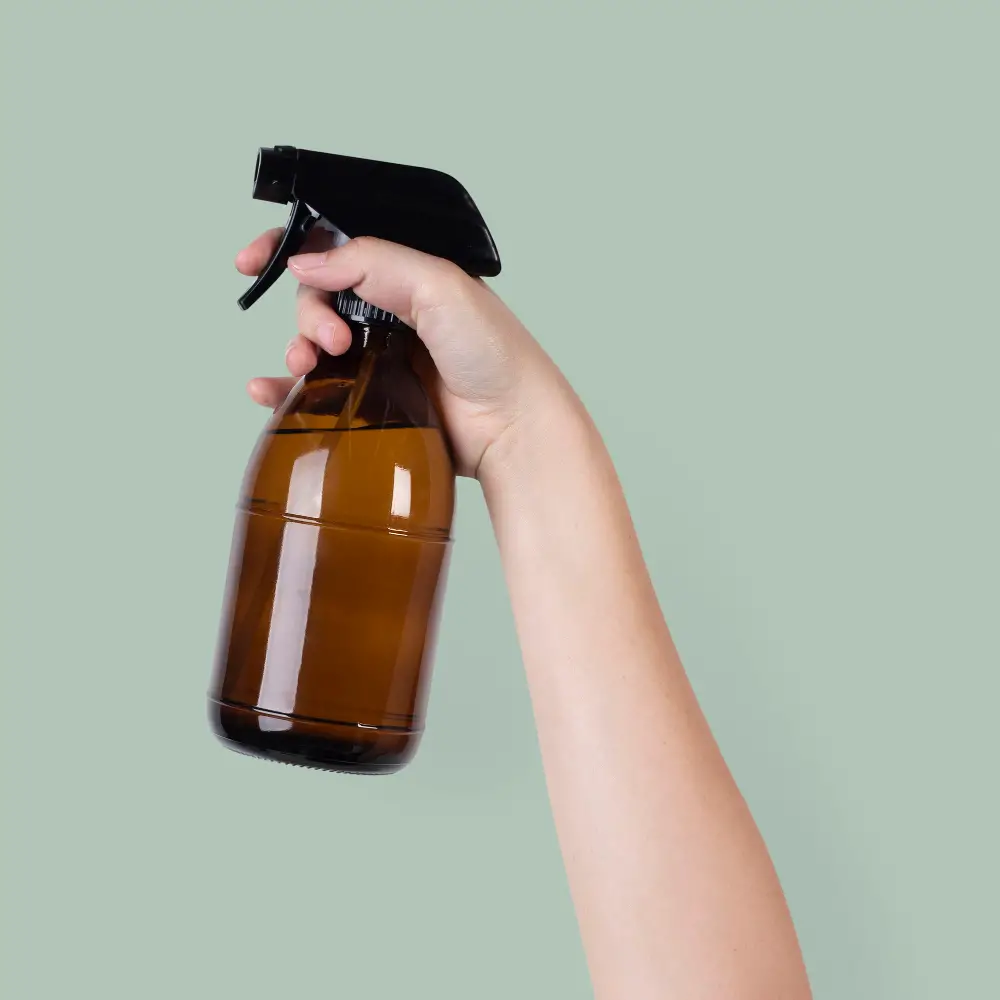
This is a great option if you have pets or small children in the house and want to avoid using harsh chemicals. To make your own disinfecting spray, mix equal parts water and white vinegar in a clean spray bottle.
You can also add essential oils like tea tree oil or lavender oil for added antibacterial properties and fragrance.
To use the homemade disinfecting spray on your fabric couch, simply mist it over the surface of the couch until it’s lightly dampened with the solution. Allow it to air dry completely before sitting on or using again.
Disinfecting Couch Slipcovers

Slipcovers can be easily removed and washed in the washing machine with hot water and detergent. You can also add a cup of white vinegar to the wash cycle for an extra boost of disinfection.
For slipcovers that cannot be washed in a machine, you can use Lysol spray or another disinfectant spray that is safe for fabrics. Simply remove the slipcover from the couch and lay it flat on a clean surface.
Spray both sides of the cover evenly with Lysol spray, making sure to cover all areas thoroughly.
Allowing enough time for drying is crucial when dealing with any type of upholstery cleaning process; this includes disinfected covers too! Once sprayed down completely let them dry out completely before putting back onto your furniture piece again.
Stain Removal Techniques
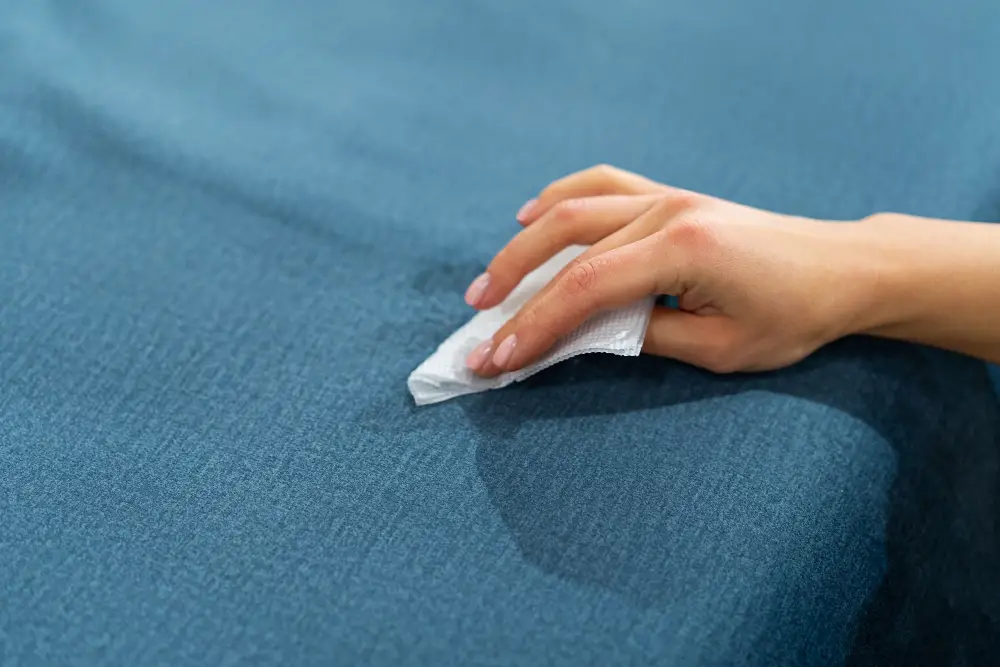
There are several techniques you can use to get rid of them. The first step is identifying the type of stain you’re dealing with, as different stains require different treatments.
For example, if your couch has a food or drink stain, start by blotting up any excess liquid with a clean cloth. Then mix together one tablespoon of dish soap and two cups of warm water in a bowl.
Dip another clean cloth into the solution and gently rub it onto the stained area until it disappears.
If your couch has an oil-based stain such as makeup or grease from food spills, sprinkle some baking soda over the affected area and let it sit for 15 minutes before vacuuming it up.
For ink stains on fabric sofas try using rubbing alcohol instead; apply some rubbing alcohol onto cotton wool then dab at the ink spot until removed.
Tips for Upholstery Cleaning

Here are some tips for upholstery cleaning that will help keep your furniture looking and smelling fresh:
1. Vacuum regularly: Use a vacuum cleaner with an upholstery attachment to remove dust, dirt, and debris from the surface of your couch.
2. Blot spills immediately: If you spill something on your couch, blot it up right away with a clean cloth or paper towel.
3. Avoid harsh chemicals: Harsh chemicals can damage the fibers in your fabric couch over time.
Stick to gentle cleaners specifically designed for upholstery cleaning.
4. Rotate cushions regularly: To prevent uneven wear and tear on the cushions of your sofa or loveseat, rotate them every few months so they get equal use.
5. Protect against pets: If you have pets that like to lounge on the furniture, consider using protective covers or throws made specifically for this purpose.
Maintaining a Fresh Couch: Preventing Couch Odors and Tips for Maintaining a Clean Couch
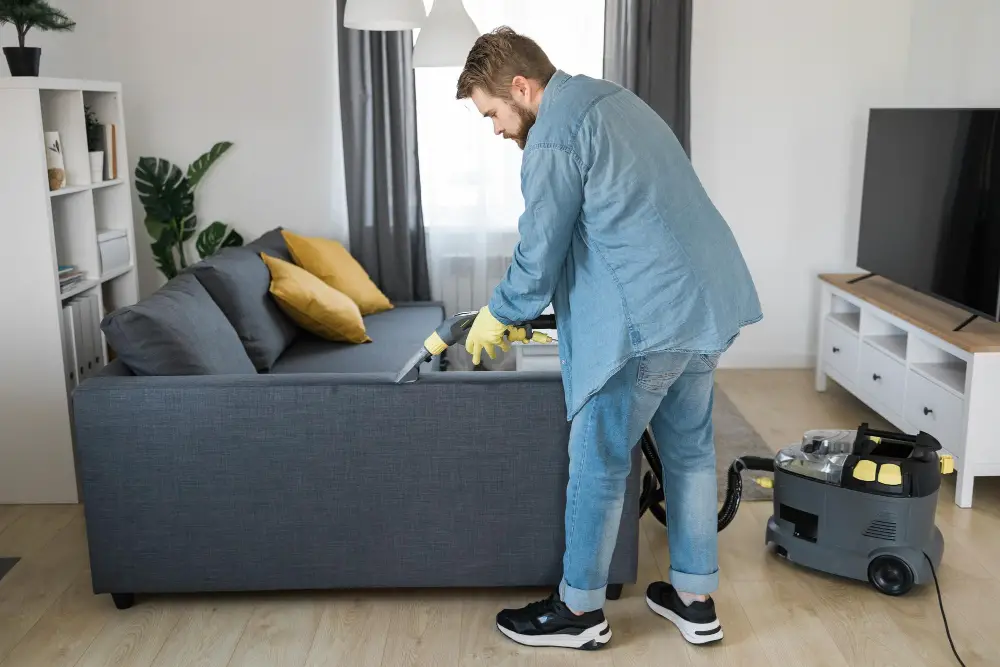
One of the most common issues with upholstered furniture is odors. To prevent unpleasant smells from developing on your couch, there are a few things you can do.
Firstly, avoid eating or drinking on the couch as much as possible. Food and drink spills can cause stains and attract bacteria that lead to bad odors.
Secondly, vacuum your couch regularly using an upholstery attachment to remove dust particles that may accumulate over time.
Thirdly, consider using odor-absorbing products such as baking soda or activated charcoal sachets placed strategically around the cushions of your sofa.
Lastly, if you have pets at home who love lounging on the sofa with you – make sure they’re clean before allowing them onto it! Regular grooming will help reduce pet hair buildup which in turn reduces any potential for unpleasant smells developing over time.
Final Thoughts On Disinfecting Fabric Couches
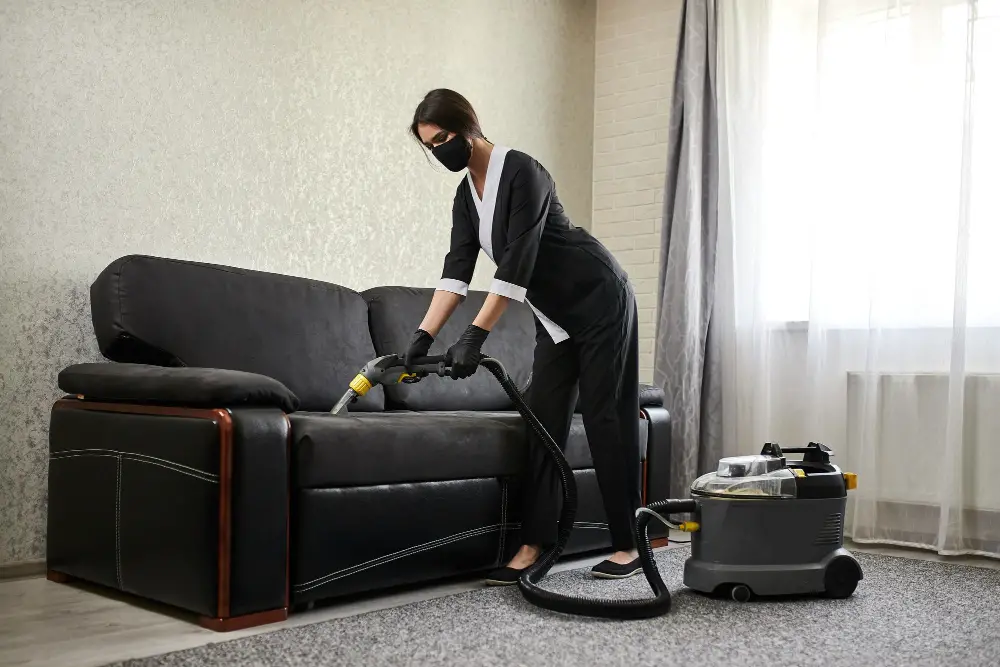
While Lysol can be a quick and easy solution for disinfecting your furniture, it’s always best to test any product on a hidden area first before applying it to the entire surface. Some fabrics may not react well with certain chemicals or sprays.
If you’re unsure about how to clean your specific type of fabric couch or have concerns about using chemical cleaners in your home, consider hiring a professional upholstery cleaner who can safely remove dirt and bacteria from deep within the fibers without damaging them.
In addition to regular cleaning practices like vacuuming and spot-cleaning spills as soon as they happen, maintaining good hygiene habits such as washing hands frequently can also help keep germs at bay. By taking these steps regularly, you’ll be able to enjoy a fresh-smelling and germ-free sofa for years to come!
FAQ
Can I use Lysol on my fabric couch?
Yes, you can use Lysol® Laundry Sanitizer on fabric couches that can be machine washed.
Can you spray Lysol on upholstered furniture?
Yes, you can spray Lysol on upholstered furniture as it effectively kills 99.9% of germs on soft surfaces, including decorative cushions, mattresses, and sofas.
How do you disinfect a fabric couch?
To disinfect a fabric couch, create a solution of 2 parts rubbing alcohol and 1 part water, pour it into a spray bottle, and lightly mist the couch from 6 inches away, allowing it to dry before sitting.
What is the best disinfectant for fabric couch?
The best disinfectant for a fabric couch is Clorox’s Hydrogen Peroxide Cleaner & Disinfectant spray, as it kills pathogens on soft surfaces and eliminates bacteria and viruses like COVID-19 in 30 seconds.
Are there any alternative methods for sanitizing a fabric sofa without using Lysol?
Yes, alternative methods for sanitizing a fabric sofa include using a steam cleaner, white vinegar, or rubbing alcohol.
What precautions should be taken when using disinfectants on fabric surfaces?
When using disinfectants on fabric surfaces, ensure to follow the product’s label instructions, pre-test on a hidden area, wear gloves, and properly ventilate the room.
How can I maintain cleanliness and reduce germs on my fabric couch regularly?
To maintain cleanliness and reduce germs on your fabric couch regularly, vacuum it frequently, use a fabric cleaner or upholstery spray to remove stains, and periodically steam-clean the entire surface.
